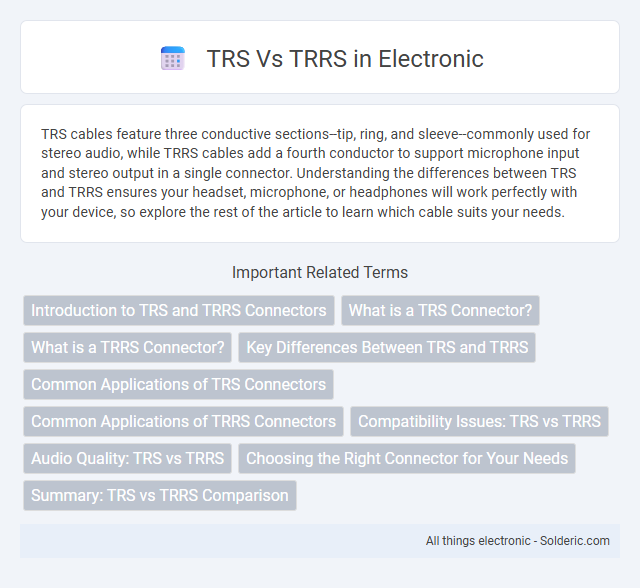TRS cables feature three conductive sections--tip, ring, and sleeve--commonly used for stereo audio, while TRRS cables add a fourth conductor to support microphone input and stereo output in a single connector. Understanding the differences between TRS and TRRS ensures your headset, microphone, or headphones will work perfectly with your device, so explore the rest of the article to learn which cable suits your needs.
Comparison Table
| Feature | TRS (Tip-Ring-Sleeve) | TRRS (Tip-Ring-Ring-Sleeve) |
|---|---|---|
| Structure | 3 Contact points: Tip, Ring, Sleeve | 4 Contact points: Tip, Ring1, Ring2, Sleeve |
| Use Case | Stereo audio (left, right, ground) | Stereo audio + microphone or video + microphone |
| Common Devices | Headphones, musical instruments, audio cables | Smartphones, headsets with mic, gaming controllers |
| Compatibility | Compatible with stereo audio outputs only | Supports audio input/output and microphone functions |
| Audio Channels | 2 channels (Left & Right) | 2 channels + mic input or video |
| Connector Size | Typically 3.5mm or 6.35mm | Typically 3.5mm |
Introduction to TRS and TRRS Connectors
TRS (Tip-Ring-Sleeve) and TRRS (Tip-Ring-Ring-Sleeve) connectors are commonly used audio jacks distinguished by their pin configuration and functionality. TRS connectors feature three contact points supporting stereo audio signals, while TRRS connectors include an extra ring to accommodate microphone input or additional data channels. These connectors are widely implemented in headphones, smartphones, and audio equipment to enable combined audio output and input capabilities.
What is a TRS Connector?
A TRS connector, standing for Tip-Ring-Sleeve, is a three-conductor audio plug commonly used for stereo headphones, balanced audio signals, and instrument cables. It consists of three distinct contact points: the tip for the left audio channel, the ring for the right audio channel, and the sleeve for ground, enabling clear left-right stereo sound transmission. TRS connectors are widely used in professional audio equipment and consumer devices, providing reliable stereo connectivity without microphone support.
What is a TRRS Connector?
A TRRS connector stands for Tip-Ring-Ring-Sleeve, featuring four contact points designed to carry stereo audio and a microphone signal simultaneously. Unlike a TRS connector that only supports stereo audio, TRRS connectors enable you to use headsets with integrated microphones for calls and recordings. This makes TRRS essential for devices like smartphones and laptops that require both audio input and output through a single jack.
Key Differences Between TRS and TRRS
TRS connectors feature three contact points: Tip, Ring, and Sleeve, typically used for stereo audio or mono audio plus ground. TRRS connectors have four contact points: Tip, Ring, Ring, and Sleeve, enabling additional functions like microphone input and stereo output in a single plug. The key difference lies in TRRS's capability to carry both audio and microphone signals, making it standard for smartphone headsets and devices requiring combined input/output.
Common Applications of TRS Connectors
TRS connectors, characterized by their tip-ring-sleeve design, are commonly used in audio equipment such as headphones, microphones, and musical instruments for stereo or mono sound transmission. These connectors support balanced audio signals, reducing noise and interference, which makes them ideal for professional audio gear and mixers. Your audio setup benefits from TRS cables when a straightforward two-channel connection without microphone input is required.
Common Applications of TRRS Connectors
TRRS connectors are widely used in smartphones, laptops, and gaming headsets to provide both audio input and output through a single jack, enabling microphone and stereo audio functionality simultaneously. They also support advanced communication devices like videocameras and voice recorders, enhancing multimedia interaction. This four-conductor plug is essential for devices requiring integrated audio and microphone connectivity, unlike TRS connectors which typically handle stereo audio only.
Compatibility Issues: TRS vs TRRS
TRS connectors feature two conductors and commonly support mono audio or stereo headphones without a microphone, while TRRS connectors include a third ring to enable both stereo audio and microphone functionality in a single plug. Compatibility issues arise when plugging a TRRS headphone into a TRS-only jack, often resulting in no microphone input or improper audio channels. Devices designed exclusively for TRRS may misinterpret TRS plugs, causing audio distortion or lack of microphone detection due to differing wiring standards.
Audio Quality: TRS vs TRRS
TRS connectors typically provide superior audio quality due to their dedicated two-channel design, minimizing signal interference and ensuring clearer sound transmission. TRRS connectors, which combine audio and microphone signals into a single plug, may introduce slight signal degradation or crosstalk, affecting audio clarity. For optimal audio performance, especially in professional or high-fidelity setups, TRS cables are generally preferred over TRRS options.
Choosing the Right Connector for Your Needs
Choosing the right connector between TRS (Tip-Ring-Sleeve) and TRRS (Tip-Ring-Ring-Sleeve) depends on your audio device and usage requirements. TRS connectors support stereo audio signals and are ideal for headphones and microphones with two channels, while TRRS connectors include an extra ring to handle stereo audio plus a microphone or remote control functions, commonly found in smartphones and gaming headsets. Ensuring compatibility with your device's port type avoids audio issues and enhances overall sound quality.
Summary: TRS vs TRRS Comparison
TRS connectors feature three conductors--tip, ring, and sleeve--commonly used for mono or stereo audio signals without microphone support. TRRS connectors include an additional ring, enabling both stereo audio and microphone functionality, making them suitable for headsets and smartphones. The key distinction lies in TRRS's capability to handle audio input and output simultaneously, streamlining communication devices.
TRS vs TRRS Infographic

 solderic.com
solderic.com